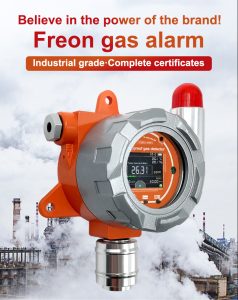Introduction Air pollution is a global environmental problem that poses serious threats to human health and the environment. In recent years, there has been an increasing focus on monitoring and improving air quality to mitigate the adverse effects of pollution. One of the key components of an effective air quality monitoring system is gas sensors. These sensors play a crucial role in detecting and measuring various pollutants in the air, enabling us to assess the level of pollution and take appropriate actions to mitigate its effects. In this article, we will explore the advancements in gas sensor technology and the role they play in advancing air quality monitoring.

Gas Sensor Technology Gas sensors are devices that detect and measure the presence and concentration of gases in the atmosphere. These sensors work by converting the chemical reactions between target gases and sensing materials into measurable electrical signals. There are different types of gas sensors, such as electrochemical, metal oxide semiconductor (MOS), and optical sensors, each with its own strengths and limitations.
Advancements in Gas Sensor Technology Over the years, gas sensor technology has significantly advanced, leading to improved accuracy, sensitivity, and selectivity of measurements. These advancements have resulted in more reliable and efficient air quality monitoring systems. Some of the notable advancements in gas sensor technology include:
- Miniaturization:
- Gas sensors have become increasingly compact and portable, allowing for easier deployment in various environments. Miniaturization has also enabled the integration of gas sensors into wearable devices, providing real-time monitoring of air quality for individuals.
- Selectivity: Gas sensors now possess a higher degree of selectivity, allowing for the identification and measurement of specific gases or groups of gases. This selectivity helps in distinguishing between different pollutants, enabling targeted pollution control measures.
- Sensitivity: Gas sensors have become more sensitive, able to detect even low concentrations of pollutants in the air. Improved sensitivity allows for better monitoring of air quality, especially in urban areas where pollution levels can vary significantly.
- Response Time: Gas sensors now have faster response times, providing real-time data on pollutant levels. This rapid response time enables timely actions to be taken to reduce exposure to harmful pollutants.
Integration with IoT and Big Data Analytics Gas sensors are increasingly being integrated with the Internet of Things (IoT) networks, allowing for real-time data collection and sharing. This integration enables the creation of comprehensive air quality monitoring networks that provide accurate and up-to-date information on pollution levels. Additionally, gas sensor data can be combined with other data sources, such as weather conditions and traffic patterns, and analyzed using big data analytics techniques. This integration and analysis allow for a deeper understanding of the factors influencing air quality and the development of effective pollution control strategies.
Applications of Gas Sensors in Air Quality Monitoring Gas sensors find extensive applications in air quality monitoring systems. Some key applications include:
- Urban Air Quality Monitoring: Gas sensors are deployed in urban areas to monitor the levels of pollutants such as nitrogen dioxide, ozone, and particulate matter. This data helps in assessing the air quality and identifying pollution hotspots.
- Industrial Emissions Monitoring: Gas sensors are used in industries to monitor and control emissions of harmful gases. By continuously monitoring emission levels, industries can take proactive measures to reduce pollution and comply with environmental regulations.
- Indoor Air Quality Monitoring: Gas sensors are utilized in buildings and homes to monitor the air quality indoors. This monitoring helps in identifying sources of indoor pollution, such as volatile organic compounds (VOCs), and taking appropriate measures to improve indoor air quality.
- Environmental Monitoring: Gas sensors are employed in environmental monitoring programs to assess the impact of pollution on ecosystems and natural resources. By monitoring pollutant levels in the environment, appropriate measures can be taken to protect ecosystems and biodiversity.

Conclusion Advancements in gas sensor technology have revolutionized air quality monitoring, enabling us to better understand and address the challenges posed by air pollution. These sensors provide accurate and real-time data on pollutant levels, helping us make informed decisions and take effective actions to protect human health and the environment. As gas sensor technology continues to evolve, we can expect further improvements in accuracy, sensitivity, and integration, leading to more comprehensive and efficient air quality monitoring systems. By harnessing the power of gas sensors and other advanced technologies, we can pave the way for cleaner and healthier air for generations to come.
 : +86 155 8830 2704
: +86 155 8830 2704 : jxdziot@gmail.com
: jxdziot@gmail.com
